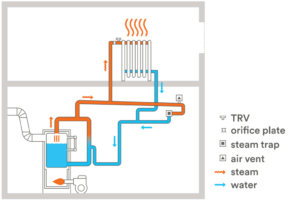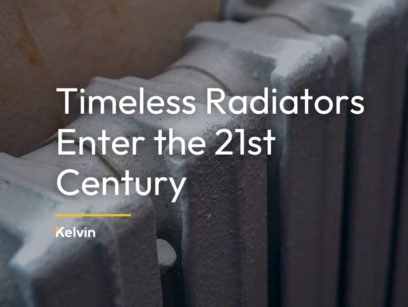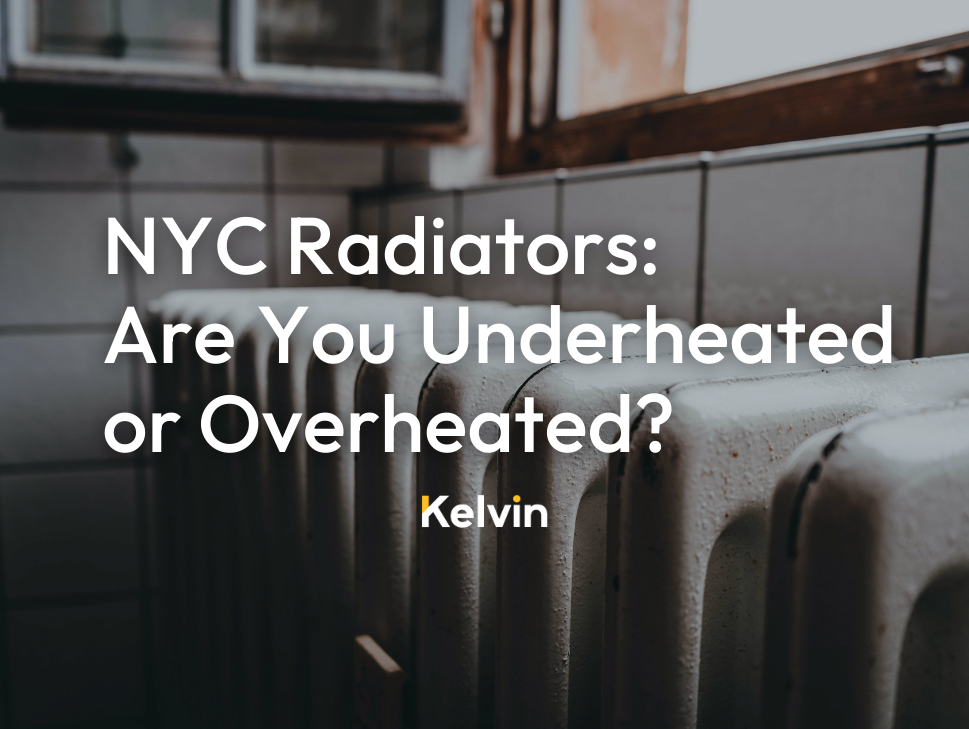
Older NYC radiators are known for their aesthetic charm in legacy buildings. However, they also introduce heating challenges, particularly during the winter season. Some radiators are almost too effective at keeping you warm, while others may not work efficiently at all. The lack of temperature control can leave apartments either too hot or too cold, making it difficult to achieve a comfortable environment. Does your NYC radiator leave you underheated or overheated?
Understanding Your building Distribution System
The best way to find a solution is to understand the type of radiator system in your apartment. Many older NYC buildings use single-pipe steam systems that limit the option for temperature control. Here’s a breakdown of common radiator types found in NYC:
1. Single-Pipe Steam System
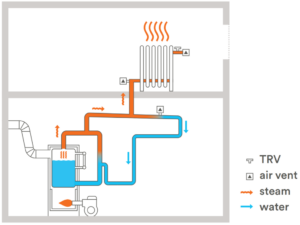
Source: Building Energy Exchange
This is the most common type of steam heating system in older buildings, especially in pre-war NYC apartments. In a single-pipe system, the same pipe supplies steam to the radiator and allows condensed water (condensate) to return to the boiler.
- Identifying It: Look for one pipe connecting to each radiator. When the steam enters, the radiator heats up, and the condensate drips back down the same pipe.
- Challenges: These systems often result in uneven heating (too hot or too cold) because the steam distribution can be inconsistent. Air vents are crucial to this system’s function, but they can get clogged.
2. Two-Pipe Steam System
Source: Building Energy Exchange
In two-pipe systems, one pipe brings steam to the radiator, and another pipe carries the condensate back to the boiler. This setup allows for better temperature control because the steam and water don’t interfere with each other.
- Identifying It: Each radiator in a two-pipe system will have two distinct pipes—one delivering steam to the radiator and the other returning condensed water (condensate) to the boiler.
- Challenges: Although more efficient than single-pipe systems, these systems can still suffer from heating imbalances, especially if air valves or traps aren’t maintained properly.
3. Hydronic (Hot Water) Systems
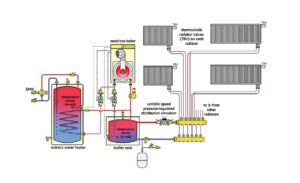
Source: Supply House Times
Hydronic systems use water rather than steam. The water is heated by a boiler and circulates through the radiators.
- Identifying It: Look for two pipes and radiators that don’t make the characteristic hissing or banging sounds associated with steam systems. Hydronic systems provide more consistent, quieter heat.
- Challenges: While generally more efficient than steam, hydronic systems can still have issues with uneven heat distribution, especially if air gets trapped in the system.
4. Metro Steam (District Steam)
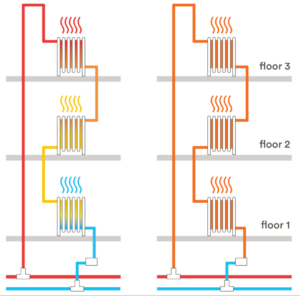
Source: Building Energy Exchange
Fig 1 (left). An imbalanced metro steam system, where the top floor receives too much heat and the bottom floor receives too little. Fig 2 (right). A properly balanced system, where each floor receives the same level of heat, and occupants can adjust temperature to match their personal preference. – Building Energy Exchange
Metro steam refers to steam that is generated centrally and supplied to multiple buildings through a network (e.g., NYC’s Con Edison steam system). Buildings connected to this system receive high-pressure steam that gets regulated for use in individual heating systems.
- Identifying It: If your building is connected to the city’s steam grid, you’ll often see a steam meter in the basement. Your building management would also handle adjustments.
- Challenges: Metro steam systems are harder to control on an individual level, as the steam comes from an external source, leading to potential overheating or inefficiency.
Can TRVs Fix Overheating or Underheating?
In most cases, TRVs are incompatible with steam systems and can cause more problems than they solve. Before making any changes, look into your building’s heating infrastructure and consult your property manager.
A Smarter Way to Control Your Radiator Heat
Kelvin’s Cozy, a smart radiator cover is an innovative solution tailored to NYC’s steam radiator systems. Unlike traditional TRVs which often don’t work with steam radiators, the Cozy is designed specifically for these systems.
- How it works: The Cozy is a smart radiator cover that insulates your radiator and uses a built-in thermostat and fan to control the heat distribution in your room. Instead of allowing uncontrolled heat to escape, the Cozy traps the warmth inside the cover and releases it only when the room temperature drops below a set threshold.
Comparing TRVs vs. Cozys
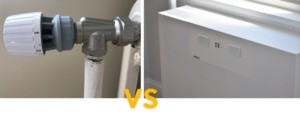
- TRVs Function: TRVs are designed to regulate the temperature of a room by adjusting the flow of steam into the radiator based on the room’s temperature.
- TRVs Effectiveness: TRVs can help with controlling overheating in steam systems, but they only offer partial control. They work well in two-pipe systems but often underperform in single-pipe steam systems due to the imprecise nature of steam heating. They also don’t fix issues like drafts or cold spots around the radiator.
- TRVs Limitations: TRVs don’t offer a comprehensive solution for uneven heating. They only modulate steam flow rather than preventing excess heat from radiating out when not needed.
Kelvin’s Cozy Radiator Covers

- Function: Cozy covers are designed to regulate the heat output more precisely by insulating the radiator and using smart sensors to control the flow of heat into the room. Cozy systems are connected to smart technology that can respond to room temperatures in real-time, adjusting the heat distribution much more efficiently.
- Effectiveness: The Cozy works with all types of radiator distribution systems. They provide a more robust solution than TRVs by reducing overheating and preventing radiators from becoming inefficient heat sources. By using sensors and data, Cozy ensures a balanced and comfortable temperature in every room.
- Advantages: Unlike TRVs, Cozy covers also reduce wasted energy and are a key solution for complying with Local Law 97 regulations. They can be retrofitted onto existing radiators, offering substantial energy savings and better overall comfort.
The Bottom Line: Control Your Heat Without Disrupting Your System
While TRVs may not be the best option for NYC apartments with steam radiators, solutions like Kelvin’s Cozy offer a more effective way to manage your heating without the complications. Whether you’re dealing with overheating or underheating, understanding your radiator type is key to choosing the right control method. Inform your property manager about the Cozy or contact us.
